
[cmamad id=”19829″ align=”center” tabid=”display-desktop” mobid=”display-desktop” stg=””]
This cheap drink may be the ticket to stronger erections for men…

—–Important Message—–
Simple solo activity fixes erection problems…
And it’s so easy any man can do it, even if he doesn’t yet have a partner.
This solo activity works by increasing blood flow to the penis – essential to getting erections…
And it works for all three types of erection problems… even if you’ve been struggling for years…
—————–
Men Drinking A2 = Better Gut Health and Higher Libido?
This newsletter shows you how to drink the right form of milk that may be MUCH better for your gut health, lower internal inflammation, and even fix blood pressure problems.
So let’s talk about milk:
There are several differences between the composition of goat’s milk and cow’s milk – such as how much vitamin A & D they have… Those differences are hardly even worth mentioning.
But there are two differences between goat’s milk and cow’s milk that can lead to very substantial effects.
Although their milk is seemingly identical at first glance, cows and goats have different DNA sequences and so they encode for different milk proteins.
Peptides and proteins have strong biological effects.
Proteins such as prolactin and insulin are endocrine hormones, while the peptides beta-endorphin and met-enkephalin are powerful opiates.
If all proteins were broken down into free amino acids in the stomach, it wouldn’t really matter what we ate…
But this is not the case.
Even entire enzymes can be absorbed whole, intact, and with full activity.
For instance: Wheat and rye have high-proline seed storage proteins that our enzymes cannot hydrolyze.
If gluten peptide fragments are then absorbed, they can raise prolactin and lower dopamine by mimicking enkephalins.
(Enkephalins are peptides that occur naturally in the brain. They are related to endorphins and have similar physiological effects.)
The immune system perceives longer peptides as foreign bodies and raises antibodies against them.
Since so many different sequences (specific combinations of amino acids) are possible in food proteins, some of the antibodies formed will always end up being auto-antibodies, just by probability alone.
[cmamad id=”19830″ align=”center” tabid=”display-desktop” mobid=”display-desktop” stg=””]
Eating resistant proteins makes auto-antibody formation a statistically foregone conclusion.
Antibodies bind the same peptides they were made to neutralize…
But some of them will also bind important body proteins such as receptors and enzymes.
Auto-antibodies are pathological self-directed antibodies… And they can be a serious problem.
For example, auto-antibodies towards the acetylcholine receptor cause myasthenia gravis.
(Myasthenia gravis is a chronic autoimmune neuromuscular disease that causes weakness in the skeletal muscles).
And auto-antibodies towards glutamic acid decarboxylase (found on pancreatic beta-cells) cause Type 1 diabetes.
Wheat is implicated in both of these conditions…
It is somewhat digestion-resistant as a defense mechanism against herbivores (cows, horses, goats, deer, etc.).
Like wheat, milk is somewhat digestion-resistant. But the purpose is a different and a bit more active.
Because milk proteins provide a safe time-release source of amino acids for infants, our bodies don’t break down their globular proteins quite as quickly as most other proteins.
The calcium in milk and cheese will also raise stomach pH, and that is not conducive to proteolysis.
(Proteolysis is the breakdown of proteins into smaller polypeptides or amino acids.)
Just like wheat, cow’s milk contains proteins that can release both opiate peptides and auto-antigens.
On the other hand, goat’s milk and sheep’s milk are entirely free of these problems.
Science has already proved all of this:
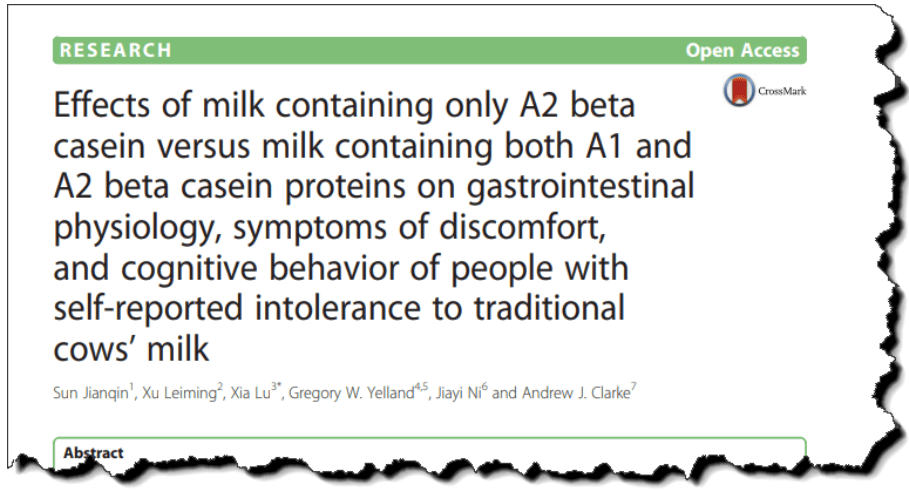
This is a new article, yet its results were predictable.
As far back as 1990, scientists observed that rats given beta-casomorphin had reduced transit time.
(“Transit time” is how long it takes for stuff to move through the gut. Interesting term, huh?)
(Casomorphin is an opioid protein fragment derived from the digestion of the milk protein casein.)
Naxolone, a Mu-opioid receptor blocker, completely prevented this effect.
Dozens of earlier studies, when taken together, pretty much proved that this was opiate-driven.

This newer study compared A1 milk to A2 milk consumed by humans.
The participants drank a pint of milk (500·mL) every day, in two doses.
AND the researchers gave them a “smart pill” to measure intestinal parameters.
Predictably, only those who consumed the A1 milk had a reduction in intestinal transit time.
The A2 isoform of casein does not contain the beta-casomorphin sequence, nor does any goat or sheep casein.
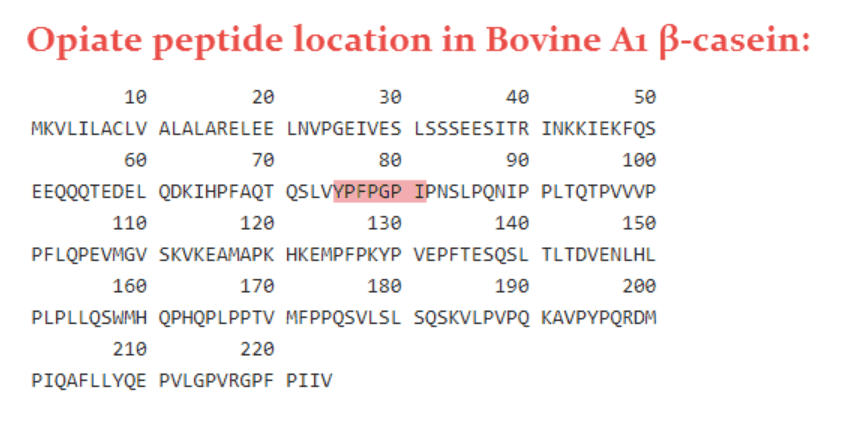
Since this particular opiate peptide was not released upon digestion, there was nothing to act on the Mu-opioid receptor in the A2 group.
“In other words, the A1 beta-casein type – but not the A2 beta-casein type – had a negative impact on gastrointestinal function.”
The group that had the A1 milk also had a lowered reaction time and lower scores on the “subtle cognitive impairment test.”
Maybe this indicates that the circulation system absorbed the beta-casomorphin.
Opiate peptides from food are routinely detected in the urine.
Coffee actually has a Mu-opioid antagonist called caffeoyl quinide. This is similar to naloxone in function.
(Naloxone is that medication we’ve all heard about that rapidly reverses opioid overdoses. It is an opioid antagonist.)
And maybe this is why coffee increases intestinal transit time in some people…especially people who get constipated when they drink milk.
“This minor impairment of cognitive function can have a considerable impact in situations where rapid stimulus detection and/or rapid decision-making are required.”
Wheat, soy, and spinach also contain proteins that release exorphins…
The soybean peptide (soymorhin) activates the Mu-opioid receptor. And peptides from wheat and spinach leaves activate the milder delta-opioid receptor.
Opiates reliably lower dopamine. And maybe this explains the reduced reaction times noted in people who consume A1 milk.
Since this exorphin also strongly binds the Mu-opiate receptor, drinking A1 milk is similar to taking low-dose morphine.
“This finding demonstrates that consumption of milk containing the A1 beta-casein type affects more than just the gastrointestinal system – there are also effects on neural function.”
You can seek out cow’s milk that is supposedly high in A2 and low in A1…
But milk from goats and sheep has almost zero A1 protein all the time.
Switching to goat’s or sheep’s milk should slightly increase nerve speed…because you avoid the A1 problem.
Milk from camels, buffalo, yaks, and donkeys is also very low in A1…
But I’m not planning to stray beyond goat’s and sheep’s milk just yet.
These issues with A1 and A2 are relatively mild compared to what a different milk protein can do to us.
And that is the soluble folate receptor FRα (folate receptor alpha).
Folate receptors are on the surface of cells.
They are responsible for the uptake of both dietary folates and tetrahydrobiopterin cofactors.
(Our bodies use tetrahydrobiopterin in the biosynthesis of the neurotransmitters serotonin, melatonin, dopamine, norepinephrine, epinephrine. It does other things too.)
Yet these receptors attach only to the cell surface by weak lipid bonds.
These receptors can be cleaved off by metalloproteinase enzymes. Maybe they can even break off spontaneously.
For these reasons, folate receptors are also dissociated – in free-floating form.
Milk does have a high concentration of soluble folate receptors.
Although these are no longer technically “receptors” when found in milk, they are still the same protein sequence.
So they get to keep their official names (FRα and FRβ – folate-receptor-alpha and folate-receptor-beta).
All brain folates must pass through receptors on the blood/brain barrier for this vitamin.
Low brain folates reliably lead to impaired brain function – this is highly associated with some forms of dementia and autism.
Scientists have detected auto-antibodies against the brain’s folate receptors – in plasma.
Folate receptors are responsible for folate and biopterin brain uptake.
So folate-receptor-blocking auto-antibodies are always accompanied by normal plasma levels – yet greatly reduced cerebrospinal fluid levels.
The soluble folate receptor in cow’s milk is about 88% similar to our own.
And this is what most convincingly explains the presence of anti-folate receptor auto-antibodies in people:
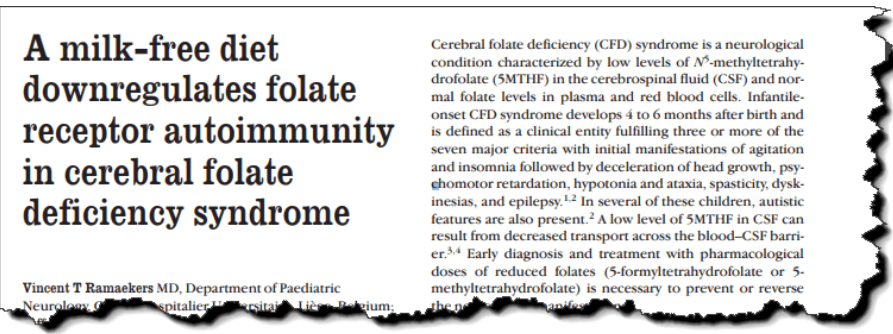
Auto-antibodies against folate receptors were first discovered around 2003…
But scientists didn’t associate them with brain folate deficiency until a few years later.
The placenta has folate receptors – and these were the prime concern of earlier studies.
To explain the presence of an auto-antibody, a logical first step could be to look for comparisons among food proteins.
Like, looking for ones exhibiting a high degree of similarity.
After scientists realized that the bovine (cow) folate receptor is about 88% identical to the human counterpart, the next logical step would be to see if auto-antibodies will in fact bind to it:
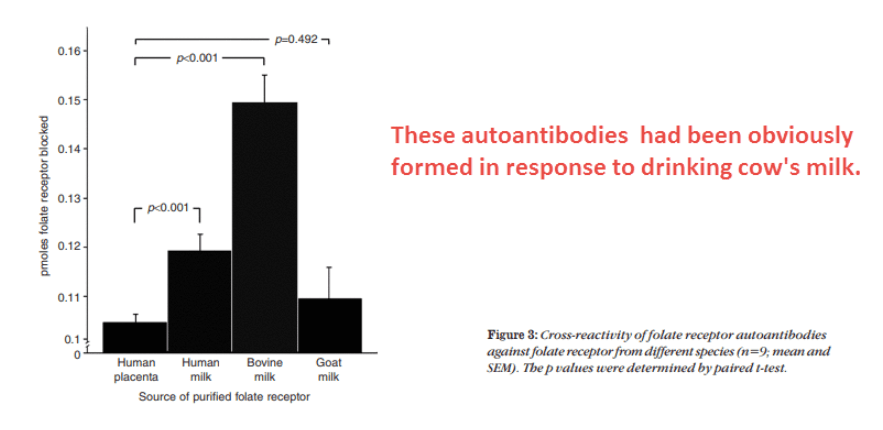
Should it bind to that protein with high affinity, then you could argue that the antibody was formed in response to it.
After it became obvious that cow’s milk was responsible for many cases of cerebral folate deficiency CFD), a scientist named Vincent Ramaekers restricted milk in 12 children.
Unsurprisingly, their symptoms greatly improved over the control group.
And that is similar to what he had observed using high-dose folinic acid.
Auto-antibody counts decreased as well – proving that the milk/auto-antibody mechanism underlies the clinical symptoms.
“However, non-compliance over a period of 6 to 14 weeks resulted in a significant increase in the mean titer to 6.53. This increase in titer was not accompanied by clinical deterioration because folinic acid supplementation was maintained throughout.”
If cerebral folate deficiency isn’t bad enough, here’s another thing…
Folate receptors on the blood/brain barrier transport tetrahydrobiopterin – and this is a necessary cofactor for brain dopamine synthesis and myelination.
Our bodies need folates for brain DNA synthesis and myelination.
If we are deficient in cerebral folate, we also may have ataxia, confusion, and sometimes even seizures.
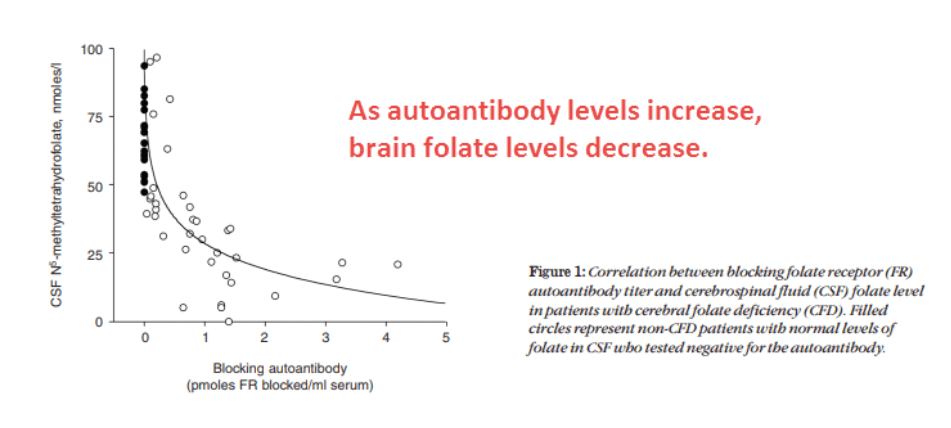
Of course, it takes a larger protein fragment to be absorbed before auto-antibodies will be produced. So this wouldn’t occur in everyone.
People with weak digestion, for whatever reason, would be the most affected.
People who eat lots of leaves and who consume lots of extra folates would have little to no symptoms.
Besides the officially named folate receptors (FRα, FRβ), the blood/brain barrier has another tool – the reduced folate carrier (RFC1).
The RFC1 is a membrane pore that can bypass the folate receptor at high intakes.
Commercial synthetic “folic acid” does not work because most of that is converted into the inactive S-enantiomer through dihydrobiopterin reductase…
And that actually blocks the receptors further.
“In the CFD syndrome, the clinical manifestations typically occur after the switch to bovine milk. One likely mechanism for auto-antibody production could be that exposure to soluble folate receptors from milk elicits an immune response.”
So, with cow’s milk, you have the opiate peptides in beta-casein to deal with. They are essentially unavoidable.
But you also have the potential to form folate receptor auto-antibodies through the soluble bovine folate receptors that are also present.
Milk and cheese from goats and sheep are entirely free of ALL of this stuff… While dairy products from A2 cows are ONLY free of ONE of these things.
If you use milk from goats or sheep, you can avoid all of this.
Or you can look for milk from A2 cows rather than A1 cows. Whether cow’s milk is A1 or A2 – only a genetic test can truly determine that.
There are companies that sell certified A2 cow’s milk, though.
But, again, there are problems with cow’s milk beyond the A1/A2 issues – the whole folate issue.
You don’t have to worry about A2 certification with goat’s or sheep’s OR about any of those other problems.
—–Important Message—–
I can make YOU a new man… Just give me 7 days…

People used to laugh at my bloated body… my beer gut and flabby arms.
I was ashamed to strip down in the locker room at the gym or take off my shirt at the pool… I could hear girls making fun of me behind my back…
THEN I discovered the secret to becoming a lean, muscular, sexual beast… without cutting calories or spending hours in the gym…
And I watched as my body transformed before my very eyes…
The fat just melted off, even while I continued eating full meals and taking naps on the couch.
Now no one is laughing at me… they’re all too busy trying to figure out my secret…
—————–

https://www.researchgate.net/profile/Hannelore_Daniel/publication/20837429_Effect_of_Casein_and_b-Casomorphins_on_Gastrointestinal_Motility_in_Rats/links/0912f51000c6536133000000/Effect-of-Casein-and-b-Casomorphins-on-Gastrointestinal-Motility-in-Rats.pdf
Antony, Aśok. "The biological chemistry of folate receptors." Blood (1992)
http://citeseerx.ist.psu.edu/viewdoc/download?doi=10.1.1.322.4551&rep=rep1&type=pdf
Mayor, Satyajit. "Sequestration of GPI-anchored proteins in caveolae triggered by cross-linking." Science (1994)
http://science.sciencemag.org/content/264/5167/1948
Ramaekers, Vincent. "A milk‐free diet downregulates folate receptor autoimmunity in cerebral folate deficiency syndrome." Developmental Medicine & Child Neurology (2008)
https://onlinelibrary.wiley.com/doi/pdf/10.1111/j.1469-8749.2008.02053.x

Leave a Reply